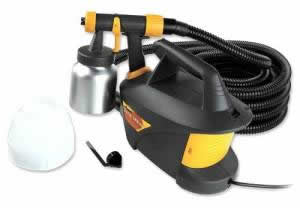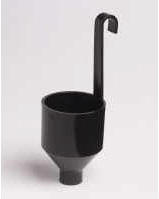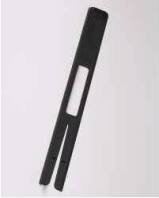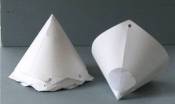Paint or other liquid finishes such as polyurethane, applied with a paint sprayer, provide the smoothest painted surface possible. That is why cars, cabinets and other high value items have their finish applied with a paint sprayer.
In many cases, even the most competent diy home handyman has problems and concerns when using a paint sprayer (Figure 1). Splatters, paint running and poor coverage are just some of the problems that are encountered when using a paint sprayer.

Figure 1 - Wagner Fine Spray Paint Sprayer
A paint sprayer is a simple device, liquid paint product is placed in a container and applying pressure to the paint in the container it is forced out of a nozzle. So why do individuals have so many problems.
Selection of paint sprayers.
Problems Associated With Using A Paint Sprayer:
- Paint is to thick:
- Paint has particles or lumps in it:
Paint sprayers require a thinner paint consistency or viscosity than paint that is applied by a brush or roller. Most paint sprayers come with a viscosity cup (Figure 2) and/or viscosity stick (Figure 3), which allows the operator to check the consistency of the paint prior to placing it in the paint sprayer container.

Figure 2 - Viscosity Cup

Figure 3 - Viscosity Stick
Different models and manufacturer's have their own requirements for the correct paint viscosity of their paint sprayers.
Using the incorrect viscosity paint in a paint sprayer will cause the nozzle to clog and/or the paint will not flow properly through the nozzle, leading to paint run and paint droplets on the item being painted.
Check the owner's manual for specific viscosity information for your model paint sprayer.
Note 1: Use the same quality thinner as the quality of the paint or finishing product. It makes little sense to purchase expensive paint and then use a cheap, inexpensive thinner. The paint or finishing product manufacture will be pleased to recommend the correct thinner for their paints and/or finishes
Note 2: If using a water based paint, I highly recommend using distilled water as the thinner. Although tap water is safe to drink, it contains chemicals which may not blend properly or be detrimental to the chemicals within the paint. Distilled water is relatively inexpensive.
Paint sprayers release the paint through a very fine hole in a nozzle. This fine hole can clog easily if there are any particles or lumps in the paint and in some cases, as the pressure in the container builds up, it will blast the particle from the nozzle creating a burst of paint onto the surface being painted.
To avoid having the paint nozzle clog, most paint sprayer manufacturers state that the paint must be strained through a filter (Figure 4). In a similar manner as a coffee filter.

Figure 4 - Paint Filter / Strainer
Some of the newer paint sprayers use an inline filter (Figure 5) to strain the paint prior to sending it to the nozzle. These inline filters must be cleaned and/or replaced periodically, in the same manner as you would replace a gas line filter in your car.

Figure 5 - Paint Spray Gun Inline Filter
In either case, the strainer or the inline filter, there are different mesh sizes. It is important that you use the correct mesh size for your paint sprayer and application. Read the manufacturer's instructions that came with your model.
